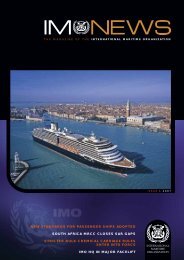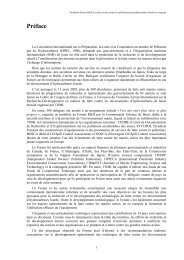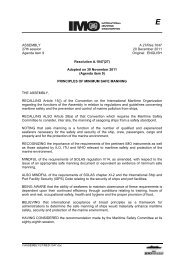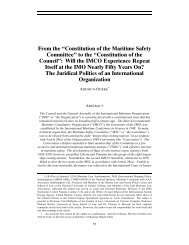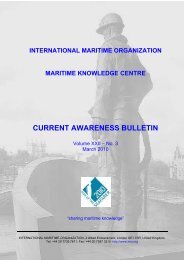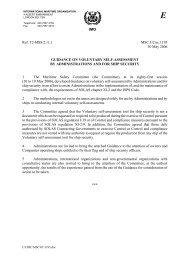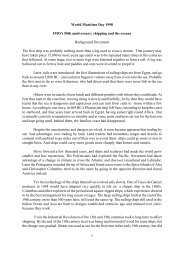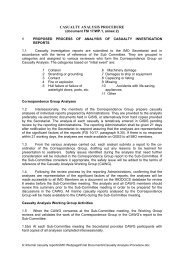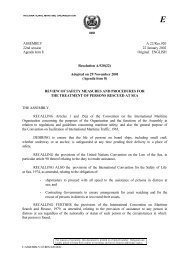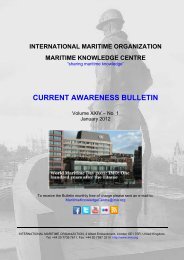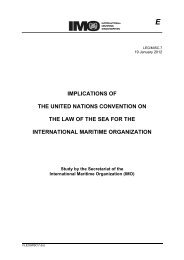Radioactive Waste Disposal at Sea: Public Ideas ... - IMO
Radioactive Waste Disposal at Sea: Public Ideas ... - IMO
Radioactive Waste Disposal at Sea: Public Ideas ... - IMO
Create successful ePaper yourself
Turn your PDF publications into a flip-book with our unique Google optimized e-Paper software.
Notes to pp. 30–35 201<br />
28. Principally Greenpeace,<br />
29. South Pacific island n<strong>at</strong>ions took the lead.<br />
30. “United Kingdom: Ocean <strong>Disposal</strong> Oper<strong>at</strong>ions to Continue,” Nuclear News<br />
(July 1983), p. 50.<br />
31. “Ocean <strong>Disposal</strong>: Japan Calls a Halt,” Nuclear News (February 1985), p. 118.<br />
32. LDC 1984, p. 31.<br />
33. LDC 1985a, Annex 2, p. 71.<br />
34. In October 1987, for example, the Japanese deleg<strong>at</strong>ion to th<strong>at</strong> year’s meeting<br />
of the global ocean dumping regime st<strong>at</strong>ed th<strong>at</strong> “although [Japan] is not presently<br />
dumping radioactive wastes <strong>at</strong> sea, it regards sea dumping as an important option<br />
for the future” (Van Dyke 1988, p. 82).<br />
35. See, e.g., Deere-Jones 1991, pp. 18–23.<br />
36. Personal communic<strong>at</strong>ion, N<strong>at</strong>ional Agency of Environmental Protection,<br />
Denmark, October 1988. Nordic environment ministers have recently appealed to<br />
British authorities to halt radioactive discharges from Sellafield. See “Stop Effluent<br />
from Sellafield,” Norden This Week, April 1998.<br />
37. See Sielen 1988.<br />
38. See Fairhall 1989; Pienaar 1989; Jones 1989, p. 251. On the recent controversy<br />
in Britain over the storage of decommissioned nuclear submarines, see Gray<br />
1996.<br />
39. The ban does not apply to waste containing de minimis levels of radioactivity.<br />
The members will conduct scientific reviews of the ban 25 years after it goes into<br />
force and <strong>at</strong> 25-year intervals thereafter.<br />
40. E. Haas (1980, p. 386) defines regime stability in an almost identical way.<br />
41. See, e.g., Sand 1992.<br />
42. See LDC 1985b, p. 10.<br />
43. See <strong>IMO</strong> 2000.<br />
44. See Timagenis 1980, pp. 4–9.<br />
Chapter 3<br />
1. Despite many insights and stimul<strong>at</strong>ing propositions regarding norms, law, order,<br />
st<strong>at</strong>es, and intern<strong>at</strong>ional organiz<strong>at</strong>ions, leading ide<strong>at</strong>ional studies generally are more<br />
concerned with structure than with transn<strong>at</strong>ional and nonst<strong>at</strong>e actors and agency<br />
more specifically. See Kr<strong>at</strong>ochwil 1989; Franck 1990; Onuf 1989. The liter<strong>at</strong>ure<br />
concerned with ideas-based policy change and constructivist liter<strong>at</strong>ure on intern<strong>at</strong>ional<br />
norms has rightly been criticized for neglecting agency. See, e.g., Checkel<br />
1999. The current deb<strong>at</strong>e about how to conceptualize the interrel<strong>at</strong>ionships between<br />
st<strong>at</strong>es and the intern<strong>at</strong>ional system, as well as the consequences for our understanding<br />
of intern<strong>at</strong>ional rel<strong>at</strong>ions th<strong>at</strong> follow from adopting various conceptualiz<strong>at</strong>ions,<br />
was introduced in Wendt 1987.



